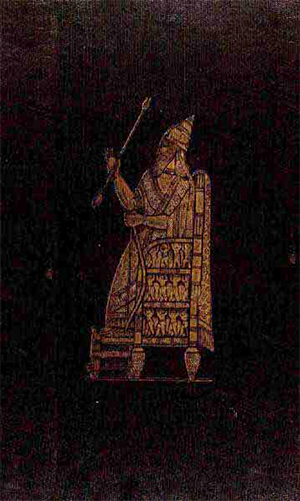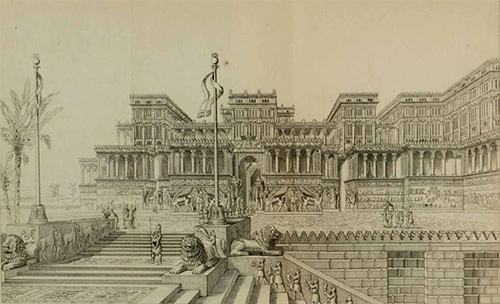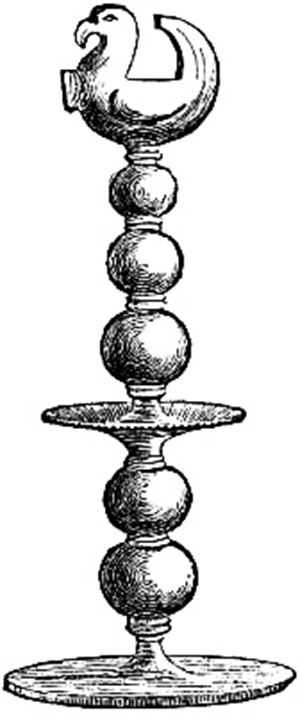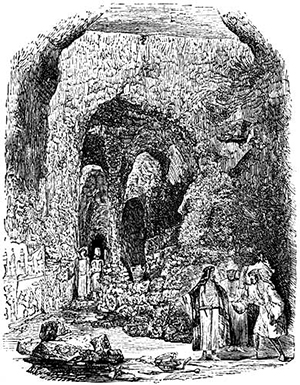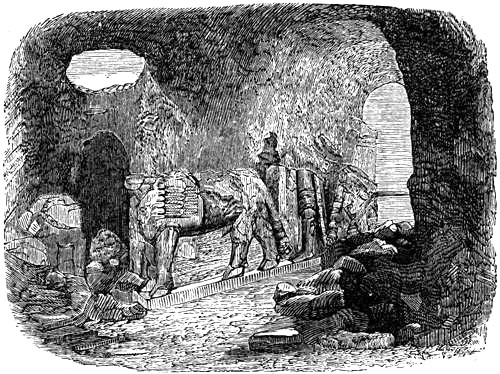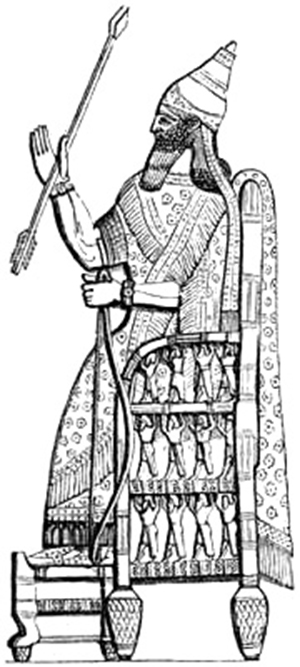CHAPTER V. RENEWAL OF EXCAVATIONS AT KOUYUNJIK.—FIRST VISIT TO NIMROUD.—STATE OF RUINS.—RENEW EXCAVATIONS IN MOUND.—VISIT OF COLONEL RAWLINSON.—MR. H. RASSAM.—THE JEBOUR WORKMEN AT KOUYUNJIK.—DISCOVERIES AT KOUYUNJIK.—SCULPTURES REPRESENTING MOVING OF GREAT STONES AND WINGED BULLS.—METHODS ADOPTED.—EPIGRAPHS ON BAS-RELIEFS OF MOVING BULLS.—SCULPTURES REPRESENTING INVASION OF MOUNTAINOUS COUNTRY, AND SACK OF CITY.—DISCOVERY OF GATEWAY.—EXCAVATION IN HIGH CONICAL MOUND AT NIMROUD.—DISCOVERY OF WALL OF STONE.—VISIT TO KHORSABAD.—DISCOVERY OF SLAB.—STATE OF THE RUINS.—FUTHLIYAH.—BAAZANI.—BAASHEIKHAH.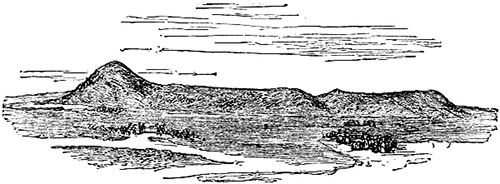 Mound of Nimroud.
Mound of Nimroud.We were again in Mosul by the 12th of October. The Jebours, my old workmen, had now brought their families to the town. I directed them to cross the river, and to pitch their tents over the excavations at Kouyunjik, as they had formerly done around the trenches at Nimroud. The Bedouins, unchecked in their forays by the Turkish authorities, had become so bold, that they ventured to the very walls of Mosul, and I felt it necessary to have a strong party on the ruins for self-defence. The Jebours[Pg 85] were, however, on good terms with the Bedouins, and had lately encamped amongst them.
About one hundred workmen, divided into twelve or fourteen parties, were employed at Kouyunjik. The Arabs, as before, removed the earth and rubbish, whilst the more difficult labor with the pick was left entirely to the Nestorian mountaineers. My old friend, Yakoub, the Rais of Asheetha, was named superintendent of the Tiyari workmen, for whom I built mud huts near the foot of the mound.
The work having been thus begun at Kouyunjik, I rode with Hormuzd to Nimroud for the first time on the 18th of October. It seemed but yesterday that we had followed the same track. We stopped at each village, and found in each old acquaintances ready to welcome us. From the crest of the hill half way, the first view of Nimroud opened upon us; the old mound, on which I had gazed so often from this spot, and with which so many happy recollections were bound up, rising boldly above the Jaif, the river winding through the plain, the distant wreaths of smoke marking the villages of Naifa and Nimroud. I dismounted at my old house, which was still standing, though somewhat in ruins, for it had been the habitation of the Kiayah during my absence, and to avoid the vermin swarming in the rooms, my tent was pitched in the court-yard, and I dwelt entirely in it.
The village had still, comparatively speaking, a flourishing appearance, and had not diminished in size since my last visit. The tanzimat, or reformed system of local administration, had been introduced into the pashalic of Mosul, and although many of its regulations were evaded, and arbitrary acts were still occasionally committed, yet on the whole a marked improvement had taken place in the dealings of the authorities with the subjects of the[Pg 86] Sultan. The great cause of complaint was the want of security. The troops under the command of the Pasha were not sufficient in number to keep the Bedouins in check, and there was scarcely a village in the low country which had not suffered more or less from their depredations. Nimroud was particularly exposed to their incursions, and the inhabitants lived in continual agitation and alarm.
By sunrise I was amongst the ruins. The mound had undergone no change. There it rose from the plain, the same sun-burnt yellow heap that it had stood for twenty centuries. The earth and rubbish, which had been heaped over the excavated chambers and sculptured slabs, had settled, and had left uncovered in sinking the upper part of several bas-reliefs. A few colossal heads of winged figures rose calmly above the level of the soil, and with two pairs of winged bulls, which had not been reburied on account of their mutilated condition, was all that remained above ground of the north-west palace, that great storehouse of Assyrian history and art.
Collecting together my old excavators from the Shemutti and Jehesh (the Arab tribes who inhabit Nimroud and Naifa), and from the tents of a few Jebours who still lingered round the village to glean a scanty subsistence after the harvest, I placed workmen in different parts of the mound. The north-west palace had not been fully explored. Most of the chambers which did not contain sculptured slabs, but were simply built of sundried bricks, had been left unopened. I consequently directed a party of workmen to resume the excavations where they had been formerly abandoned. New trenches were also opened in the ruins of the centre palace, where, as yet, no sculptures had been discovered in their original position against the walls. The high conical mound forming the north-west[Pg 87] corner of Nimroud, the pyramid as it has usually been called, had always been an object of peculiar interest, which want of means had hitherto prevented me fully examining. With the exception of a shaft, about forty feet deep, sunk nearly in the centre, and passing through a solid mass of sun-dried bricks, no other opening had been made into this singular ruin. I now ordered a tunnel to be carried into its base on the western face, and on a level with the conglomerate rock upon which it rested.
As I ascended the mound next morning I perceived a group of travellers on its summit, their horses picketted in the stubble. Ere I could learn what strangers had thus wandered to this remote region, my hand was seized by the faithful Bairakdar. Beneath, in an excavated chamber, wrapped in his travelling cloak, was Rawlinson deep in sleep, wearied by a long and harassing night’s ride. For the first time we met in the Assyrian ruins, and besides the greetings of old friendship there was much to be seen together, and much to be talked over. The fatigues of the journey had, however, brought on fever, and we were soon compelled, after visiting the principal excavations, to take refuge from the heat of the sun in the mud huts of the village. The attack increasing in the evening it was deemed prudent to ride into Mosul at once, and we mounted our horses in the middle of the night.
During two days Col. Rawlinson was too ill to visit the excavations at Kouyunjik. On the third we rode together to the mound. After a hasty survey of the ruins we parted, and he continued his journey to Constantinople and to England, to reap the laurels of a well-earned fame.
My readers would be wearied were I to relate, day by day, the progress of the excavations, and to record, as they were gradually made, the discoveries in the various ruins. It will give a more complete idea of the results of[Pg 88] the researches to describe the sculptured walls of a whole chamber when entirely explored, instead of noting, one by one, as dug out, bas-reliefs which form but part of the same subject. I will, therefore, merely mention that during the months of October and November, my time was spent between Kouyunjik and Nimroud, and that the excavations were carried on at both places without interruption. Mr. Cooper was occupied in drawing the bas-reliefs discovered at Kouyunjik, living in Mosul, and riding over daily to the ruins. To Mr. Hormuzd Rassam, who usually accompanied me in my journeys, were confided, as before, the general superintendence of the operations, the payment of the workmen, the settlement of disputes, &c. His services were invaluable, and of the greatest consequence to the success of my labors.
The Arab workmen were divided into several classes, and their wages varied according to their respective occupations, as well as according to the time of year. They were generally paid weekly by Hormuzd. The diggers, who were exposed to very severe labor, and even to considerable risk, received from two piastres and a half to three piastres (from 5d. to 6d.) a-day; those who filled the baskets from two piastres to two and a half; and the general workmen from one and a half to two piastres. The earth, when removed, was sifted by boys, who earned about one piastre for their day’s labor. These wages may appear low, but they are amply sufficient for the support of a family in a country where the camel-load of wheat (nearly 480 lbs.) is sold for about four shillings, and where no other protection from the inclemencies of the weather is needed than a linen shirt and the black folds of an Arab tent.[31]
[Pg 89]The Kouyunjik workmen were usually paid in the subterraneous galleries, some convenient space where several passages met being chosen for the purpose; those of Nimroud generally in the village. A scene of wild confusion ensued on these occasions, from which an inexperienced observer might argue a sad want of order and method. This was, however, but the way of doing business usual in the country. When there was a difference of opinion, he who cried the loudest gained the day, and after a desperate struggle of voices matters relapsed into their usual state, every one being perfectly satisfied. Screaming and gesticulation with Easterns by no means signify ill will, or even serious disagreement. Without them, except of course amongst the Turks, who are staid and dignified to a proverb, the most ordinary transactions cannot be carried on, and they are frequently rather symptoms of friendship than of hostility.
By the end of November several entire chambers had been excavated at Kouyunjik, and many bas-reliefs of great interest had been discovered. The four sides of the hall, part of which has already been described,[32] had now been explored.[33] In the centre of each side was a grand entrance, guarded by colossal human-headed bulls.[34][Pg 90] This magnificent hall was no less than 124 feet in length by 90 feet in breadth, the longest sides being those to the north and south. It appears to have formed a centre, around which the principal chambers in this part of the palace were grouped. Its walls had been completely covered with the most elaborate and highly-finished sculptures. Unfortunately all the bas-reliefs, as well as the gigantic monsters at the entrances, had suffered more or less from the fire which had destroyed the edifice; but enough of them still remained to show the subject, and even to enable me in many places to restore it entirely.
The narrow passage leading from the great hall at the south-west corner had been completely explored. Its sculptures have already been described.[35] It opened into a chamber 24 feet by 19, from which branched two other passages. The one to the west was entered by a wide doorway, in which stood two plain spherical stones about three feet high, having the appearance of the bases of columns, although no traces of any such architectural ornament could be found. This was the entrance into a broad and spacious gallery, about 218 feet long and 25 wide. A tunnel at its western end, cut through the solid wall, as there was no doorway on this side of the gallery, led into the chambers excavated by Mr. Ross, thus connecting them with the rest of the building.
I have already described the bas-reliefs representing the conquest of a mountainous country on the southern side of the great hall.[36] The same subject was continued on the western wall, without much variety in the details. But on the northern, the sculptures differed from any others yet discovered, and from their interest and novelty[Pg 91] merit a particular notice. But before giving a description of them, I must return to the long gallery to the west of the great hall, as the sculptures still preserved in it form part of and complete this important series.
The slabs on one side of this gallery had been entirely destroyed, except at the eastern end; and from the few which still remained, every trace of sculpture had been carefully removed by some sharp instrument. Along the opposite wall (that to the right on leaving the great hall) only eight bas-reliefs still stood in their original position, and even of these only the lower part was preserved. Detached fragments of others were found in the rubbish, and from them I ascertained that the whole gallery had been occupied by one continuous series, representing the different processes adopted by the Assyrians in moving and placing various objects used in their buildings, and especially the human-headed bulls, from the first transport of the huge stone in the rough from the quarry, to the raising of these gigantic sculptures in the gateways of the palace-temples. On these fragments were seen the king in his chariot, superintending the operations, and workmen carrying cables, or dragging carts loaded with coils of ropes, and various implements for moving the colossi.
I will commence, then, by a description of the sculptures still standing in their original position in the gallery. A huge block of stone (probably of the alabaster used in the Assyrian edifices), somewhat elongated in form so as to resemble an obelisk in the rough, is lying on a low flat-bottomed boat floating on a river. It has probably been towed down the Tigris from some quarry, and is to be landed near the site of the intended palace, to be carved by the sculptor into the form of a colossal bull. It exceeds the boat considerably in length, projecting[Pg 92] beyond both the head and stern, and is held by upright beams fastened to the sides of the vessel, and kept firm in their places by wooden wedges. Two cables are passed through holes cut in the stone itself, and a third is tied to a strong pin projecting from the head of the boat. Each cable is held by a large body of men, who pull by means of small ropes fastened to it and passed round their shoulders. Some of these trackers walk in the water, others on dry land. The number altogether represented must have been nearly 300, about 100 to each cable, and they appear to be divided into distinct bands, each distinguished by a peculiar costume. Some wear a kind of embroidered turban, through which their long hair is gathered behind; the heads of others are encircled by a fringed shawl, whose ends hang over the ears and neck, leaving the hair to fall in long curls upon the shoulders. Many are represented naked, but the greater number are dressed in short chequered tunics, with a long fringe attached to the girdle. They are urged on by taskmasters armed with swords and staves. The boat is also pushed by men wading through the stream. An overseer, who regulates the whole proceedings, is seated astride on the fore-part of the stone. His hands are stretched out in the act of giving commands.
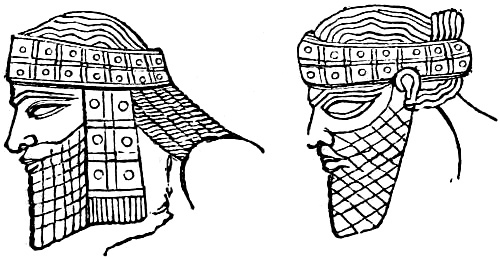 Head-dress of Captives employed by Assyrians in moving Bull (Kouyunjik).
Head-dress of Captives employed by Assyrians in moving Bull (Kouyunjik).The huge stone having been landed, and carved by the Assyrian sculptor into the form of a colossal human-headed bull, is to be moved from the bank of the river to the site it is meant to occupy permanently in the palace-temple. This process is represented on the walls of[Pg 93] the great hall. From these bas-reliefs, as well as from discoveries to be hereafter mentioned, it is therefore evident that the Assyrians sculptured their gigantic figures before, and not after, the slabs had been raised in the edifice, although all the details and the finishing touches were not put in, as it will be seen, until they had been finally placed.[37] I am still, however, of opinion, that the smaller bas-reliefs were entirely executed after the slabs had been attached to the walls.
In the first bas-relief I shall describe, the colossal bull rests horizontally on a sledge similar in form to the boat containing the rough block from the quarry, but either in the carving the stone has been greatly reduced in size, or the sledge is much larger than the boat, as it considerably exceeds the sculpture in length. The bull faces the spectator, and the human head rests on the fore-part of the sledge, which is curved upwards and strengthened by a thick beam, apparently running completely through from side to side. The upper part, or deck, is otherwise nearly horizontal; the under, or keel, being slightly curved throughout. Props, probably of wood, are placed under different parts of the sculpture to secure an equal pressure. The sledge was dragged by cables, and impelled by levers. The cables are four in number; two fastened to strong projecting pins in front, and two to similar pins behind. They are pulled by small ropes passing over the shoulders of the men, as in the bas-reliefs already described.
On the bull itself are four persons, probably the superintending officers. The first is kneeling, and appears to be clapping his hands, probably beating time, to regulate[Pg 94] the motions of the workmen, who unless they applied their strength at one and the same moment would be unable to move so large a weight. Behind him stands a second officer with outstretched arm, evidently giving the word of command. The next holds to his mouth, either a speaking-trumpet, or an instrument of music. If the former, it proves that the Assyrians were acquainted with a means of conveying sound, presumed to be of modern invention. In form it undoubtedly resembles the modern speaking-trumpet, and in no bas-relief hitherto discovered does a similar object occur as an instrument of music. The fourth officer, also standing, carries a mace, and is probably stationed behind to give directions to those who work the levers. The sledge bearing the sculpture is followed by men with coils of ropes and various implements, and drawing carts laden with cables and beams.
A subject similar to that just described is represented in another series of bas-reliefs, with even fuller details. The bull is placed in the same manner on the sledge, which is also moved by cables and levers. It is accompanied by workmen with saws, hatchets, pick-axes, shovels, ropes, and props, and by carts carrying cables and beams. Upon it are three officers directing the operations, one holding the trumpet in his hands, and in front walk four other overseers. Above the sledge and the workmen are rows of trees, and a river on which are circular boats resembling in shape the “kufas,” now used on the lower part of the Tigris, and probably, like them, built of reeds and ozier twigs, covered with square pieces of hide. They are heavily laden with beams and implements required for moving the bulls.
On a fallen slab, forming part of the same general series, is the king standing in a richly decorated chariot, the pole of which, curved upwards at the end, and [Pg 95]ornamented with the head of a horse, is raised by eunuchs. From the peculiar form of this chariot and the absence of a yoke, it would seem to have been intended purposely for such occasions as that represented in the bas-relief, and to have been a kind of moveable throne drawn by men and not by horses. Behind the monarch, who holds a kind of flower, or ornament in the shape of the fruit of the pine, in one hand, stand two eunuchs, one raising a parasol to shade him from the sun, the other cooling him with a fan. He appears to have been superintending the transport of one of the colossal sculptures, and his chariot is preceded and followed by his body-guard armed with maces.
The next series of bas-reliefs represents the building of the artificial platforms on which the palaces were erected, and the Assyrians moving to their summit the colossal bulls. The king is again seen in his chariot drawn by eunuchs, whilst an attendant raises the royal parasol above his head. He overlooks the operations from that part of the mound to which the sledge is being dragged, and before him stands his body-guard, a long line of alternate spearmen and archers, resting their arms and shields upon the ground. At the bottom of the slab is represented a river, on the banks of which are seen men raising water by a simple machine, still generally used for irrigation in the East, as well as in Southern Europe, and called in Egypt a shadoof. It consists of a long pole, balanced on a shaft of masonry, and turning on a pivot; to one end is attached a stone, and to the other a bucket, which, after being lowered into the water and filled, is easily raised by the help of the opposite weight. Its contents are then emptied into a conduit communicating with the various watercourses running through the fields. In the neighbourhood of Mosul this[Pg 96] mode of irrigation is now rarely used, the larger skins raised by oxen affording a better supply, and giving, it is considered, less trouble to the cultivator.[38]
It would appear that the men employed in building the artificial mound were captives and malefactors, for many of them are in chains, some singly, others bound together by an iron rod attached to rings in their girdles. The fetters, like those of modern criminals, confine the legs, and are supported by a bar fastened to the waist, or consist of simple shackles round the ankles. They wear a short tunic, and a conical cap, somewhat resembling the Phrygian bonnet, with the curved crest turned backwards, a costume very similar to that of the tribute bearers on the Nimroud obelisk. Each band of workmen is followed and urged on by task-masters armed with staves.
The mound, or artificial platform, having been thus built, not always, as it has been seen, with regular layers of sun-dried bricks, but frequently in parts with mere heaped-up earth and rubbish, the next step was to drag to its summit the colossal figures prepared for the palace. As some of the largest of these sculptures were full twenty feet square, and must have weighed between forty and fifty tons, this was no easy task with such means as the Assyrians possessed. The only aid to mere manual strength was derived from the rollers and levers.
Behind the monarch, on an adjoining slab, are carts bearing the cables, wedges, and implements required in moving the sculpture. A long beam or lever is slung by ropes from the shoulders of three men, and one of the great wedges is carried in the same way. In the upper[Pg 97] compartment of this slab is a stream issuing from the foot of hills wooded with vines, fig-trees, and pomegranates. Beneath stands a town or village, the houses of which have domes and high conical roofs, probably built of mud, as in parts of northern Syria. The domes have the appearance of dish-covers with a handle, the upper part being topped by a small circular projection, perhaps intended as an aperture to admit light and air.
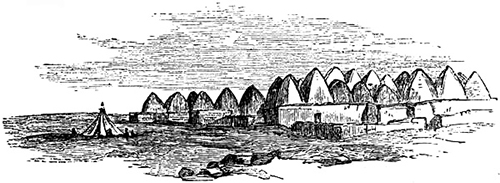 Village with the conical Roofs, near Aleppo.
Village with the conical Roofs, near Aleppo.This interesting series is completed by a bas-relief, showing, it would seem, the final placing of the colossal bull. The figure no longer lies horizontally on the sledge, but is raised by men with ropes and forked wooden props. It is kept in its erect position by beams, held together by cross bars and wedges,[39] and is further supported by blocks of stone, or wood, piled up under the body. Cables, ropes, rollers, and levers are also employed on this occasion to move the gigantic sculpture. The captives are distinguished by the peculiar turbans before described.[40]
We have thus represented, with remarkable fidelity[Pg 98] and spirit[41], the several processes employed to place these colossi where they still stand, from the transport down the river of the rough block to the final removal of the sculptured figure to the palace. From these bas-reliefs we find that the Assyrians were well acquainted with the lever and the roller, and that they ingeniously made use of the former by carrying with them wedges, of different dimensions, and probably of wood, to vary the height of the fulcrum. When moving the winged bulls and lions now in the British Museum from the ruins to the banks of the Tigris, I used almost the same means. The Assyrians, like the Egyptians, had made considerable progress in rope twisting, an art now only known in its rudest state in the same part of the East. The cables appear to be of great length and thickness, and ropes of various dimensions are represented in the sculptures.
On comparing representations of similar works among the Egyptians, it will be found that they succeeded in removing masses of stone far exceeding in weight any sculpture which has yet been discovered in Assyria. Yet it is a singular fact, that whilst the quarries of Egypt bear witness of themselves to the stupendous nature of the works of the ancient inhabitants of the country, and still show on their sides engraved records of those who made them, no traces whatever, notwithstanding the most careful research, have yet been found to indicate from whence the builders of the Assyrian palaces obtained their large slabs of alabaster. That they were in the immediate neighbourhood of Nineveh there is scarcely any reason to doubt, as strata of this material, easily accessible, abound, not only in the hills but in the plains. This very [Pg 99]abundance may have rendered any particular quarry unnecessary, and blocks were probably taken as required from convenient spots, which have since been covered by the soil.
There can be no doubt, as will hereafter be shown, that the king represented as superintending the building of the mounds and the placing of the colossal bulls is Sennacherib himself, and that the sculptures celebrate the building at Nineveh of the great palace and its adjacent temples described in the inscriptions as the work of this monarch. Unfortunately only fragments of the epigraphs have been preserved. From them it would appear that the transport of more than one object was represented on the walls. Besides bulls and sphynxes in stone are mentioned figures in some kind of wood, perhaps of olive, like “the two cherubims of olive tree, each ten cubits high,” in the temple of Solomon.[42] Over the king superintending the removal of one of these colossi is the following short inscription thus translated by Dr. Hincks:—
“Sennacherib, king of Assyria, the great figures of bulls, which in the land of Belad, were made for his royal palace at Nineveh, he transported thither.” (?)
The land of Belad, mentioned in these inscriptions, appears to have been a district in the immediate vicinity of Nineveh, and probably on the Tigris, as these great masses of stone would have been quarried near the river for the greater convenience of moving them to the palace. The district of Belad may indeed have been that in which the city itself stood.
Over the representation of the building of the mound there were two epigraphs, both precisely similar, but both[Pg 100] unfortunately much mutilated. As far as they can be restored, they have thus been interpreted by Dr. Hincks:—
“Sennacherib, king of Assyria. Hewn stones, which, as the gods[43] willed, were found in the land of Belad, for the walls (?) (or foundations, the word reads ‘shibri’) of my palace, I caused the inhabitants of foreign countries (?) and the people of the forests (Kershani), the great bulls for the gates of my palace to drag (?) (or bring).”
If this inscription be rightly rendered, we have direct evidence that captives from foreign countries were employed in the great public works undertaken by the Assyrian kings, as we were led to infer, from the variety of costume represented in the bas-reliefs, and from the fetters on the legs of some of the workmen. The Jews themselves, after their captivity, may have been thus condemned to labor, as their forefathers had been in Egypt, in erecting the monuments of their conquerors; and we may, perhaps, recognise them amongst the builders portrayed in the sculptures.
From the long gallery, we have unfortunately only three fragments of inscriptions without the sculptured representations of the events recorded. The most perfect is interesting on more than one account. According to Dr. Hincks it is to be translated:—
“Sennacherib, king of Assyria ... (some object, the nature not ascertained) of wood, which from the Tigris I caused to be brought up (through ?) the Kharri, or Khasri, on sledges (or boats), I caused to be carried (or to mount).”
The name of the river in this inscription very nearly resembles that of the small stream which sweeps round the foot of the great mound of Kouyunjik.
[Pg 101]In the fragment of another epigraph, we have mention of some objects also of wood “brought from Mount Lebanon, and taken up (to the top of the mound) from the Tigris.” These may have been beams of cedar, which, it will be hereafter seen, were extensively used in the Assyrian palaces. It is highly interesting thus to find the inhabitants of Nineveh fetching their rare and precious woods from the same spots that king Solomon had brought the choicest woodwork of the temple of the Lord and of his own palaces.
On a third fragment similar objects are described as coming from or up the same Kharri or Khasri. I have mentioned that the long gallery containing the bas-relief representing the moving of the great stone, led out of a chamber, whose walls had been completely uncovered. The sculptures upon them were partly preserved, and recorded the conquest of a city standing on a broad river, in the midst of mountains and forests.
The last bas-relief of the series represented the king seated within a fortified camp, on a throne of elaborate workmanship, and having beneath his feet a footstool of equally elegant form. He was receiving the captives, who wore long robes falling to their ankles. Unfortunately, no inscription remained by which we might identify the conquered nation.
It will be remembered that excavations had been resumed in a lofty mound in the north-west line of walls forming the enclosure round Kouyunjik. It was apparently the remains of a gate leading into this quarter of the city, and part of a building, with fragments of two colossal winged figures, had already been discovered in it. By the end of November, the whole had been explored, and the results were of considerable interest. As the mound rises nearly fifty feet over the plain, we were[Pg 102] obliged to tunnel along the walls of the building within it, through a compact mass of rubbish, consisting almost entirely of loose bricks. Following the rows of low limestone slabs, from the south side of the mound, and passing through two halls or chambers, we came at length to the opposite entrance. This gateway, facing the open country, was formed by a pair of majestic human-headed bulls, fourteen feet in length, still entire, though cracked and injured by fire. They were similar in form to those of Khorsabad and Kouyunjik, wearing the lofty head-dress, richly ornamented with rosettes, and edged with a fringe of feathers peculiar to that period. Their faces were in full, and the relief was high and bold. More knowledge of art was shown in the outline of the limbs and in the delineation of the muscles, than in any sculpture I have seen of this period. The naked leg and foot were designed with a spirit and truthfulness worthy of a Greek artist. It is, however, remarkable that the four figures were unfinished, none of the details having been put in, and parts being but roughly outlined.
The sculptures to the left, on entering from the open country, were in a far more unfinished state than those on the opposite side. The hair and beard were but roughly marked out, square bosses being left for carving the elaborate curls. The horned cap of the human-headed bull was, as yet, unornamented, and the wings merely outlined. The limbs and features were hard and angular, still requiring to be rounded off, and to have expression given to them by the finishing touch of the artist. The other two figures were more perfect. No inscription had yet been carved on either sculpture.
The entrance formed by these colossal bulls was fourteen feet and a quarter wide. It was paved with large slabs of limestone, still bearing the marks of chariot[Pg 103] wheels. The sculptures were buried in a mass of brick and earth, mingled with charcoal and charred wood; for “the gates of the land had been set wide open unto the enemy, and the fire had devoured the bars.”[44] They were lighted from above by a deep shaft sunk from the top of the mound. It would be difficult to describe the effect produced, or the reflections suggested by these solemn and majestic figures, dimly visible amidst the gloom, when, after winding through the dark, underground passages, you suddenly came into their presence. Between them Sennacherib and his hosts had gone forth in all their might and glory to the conquest of distant lands, and had returned rich with spoil and captives, amongst whom may have been the handmaidens and wealth of Israel. Through them, too, the Assyrian monarch had entered his capital in shame, after his last and fatal defeat. Then the lofty walls, now but long lines of low, wave-like mounds, had stretched far to the right and to the left—a basement of stone supporting a curtain of solid brick masonry, crowned with battlements and studded with frowning towers.
Behind the colossal figures, and between the outer and inner face of the gateway, were two chambers, nearly 70 feet in length, by 23 in breadth. Of that part of the entrance which was within the walls, only the fragments of winged figures, discovered during my previous researches, now remained.
The whole entrance thus consisted of two distinct chambers and three gateways, two formed by human-headed bulls, and a third between them simply panelled with low limestone slabs like the chambers. Its original height, including the tower, must have been full one hundred feet. Most of the baked bricks found amongst the[Pg 104] rubbish bore the name of Sennacherib, the builder of the palace of Kouyunjik. A similar gateway, but without any remains of sculptured figures, and panelled with plain alabaster slabs, was subsequently discovered in the inner line of walls forming the eastern side of the quadrangle, where the road to Baashiekhah and Baazani leaves the ruins.
At Nimroud discoveries of very considerable importance were made in the high conical mound at the north-west corner. Desirous of fully exploring that remarkable ruin, I had employed nearly all the workmen in opening a tunnel into its western base. After penetrating for no less than eighty-four feet through a compact mass of rubbish, composed of loose gravel, earth, burnt bricks, and fragments of stone, the excavators came to a wall of solid stone masonry. I have already observed that the edifice covered by this high mound was originally built upon the natural rock, a bank of hard conglomerate rising about fifteen feet above the plain, and washed in days of yore by the waters of the Tigris. Our tunnel was carried for thirty-four feet on a level with this rock, which appears to have been covered by a kind of flooring of sun-dried bricks, probably once forming a platform in front of the building. It was buried to the distance of thirty feet from the wall, by baked bricks, broken and entire, and by fragments of stone, remains of the superstructure once resting upon the basement of still existing stone masonry. This mass of rubbish was about thirty feet high, and in it were found bones apparently human, and a yellow earthen jar, rudely colored with simple black designs. The rest of this part of the mound consisted of earth, through which ran two thin lines of extraneous deposit, one of pebbles, the other of fragments of brick and pottery. I am totally at a loss to account for their formation.
[Pg 105]I ordered tunnels to be carried along the basement wall in both directions, hoping to reach some doorway or entrance, but it was found to consist of solid masonry, extending nearly the whole length of the mound. Its height was exactly twenty feet, which, singularly enough, coincides with that assigned by Xenophon to the stone basement of the wall of the city (Larissa).[45] The stones in this structure were carefully fitted together, though not united with mortar, unless the earth which filled the crevices was the remains of mud, used, as it still is in the country, as a cement. They were bevelled with a slanting bevel, and in the face of the wall were eight recesses or false windows, four on each side of a square projecting block between gradines.
The basement, of which this wall proved to be only one face, was not excavated on the northern and eastern side until a later period, but I will describe all the discoveries connected with this singular building at once. The northern side was of the same height as, and resembled in its masonry, the western. It had a semicircular hollow projection in the centre, sixteen feet in diameter, on the east side of which were two recesses, and on the west four, so that the two ends of the wall were not uniform. That part of the basement against which the great artificial mound or platform abutted, and which was consequently concealed by it, that is, the eastern and southern sides, was of simple stone masonry without recesses or ornament. The upper part of the edifice, resting on the stone substructure, consisted of compact masonry of burnt bricks, which were mostly inscribed with the name of the founder of the centre palace (the obelisk king), the inscription being in many instances turned outwards.
[Pg 106]It was thus evident that the high conical mound forming the north-west corner of the ruins of Nimroud, was the remains of a square tower, and not of a pyramid, as had previously been conjectured. The lower part, built of solid stone masonry, had withstood the wreck of ages, but the upper walls of burnt brick, and the inner mass of sun-dried brick which they encased, falling outwards, and having been subsequently covered with earth and vegetation, the ruin had taken the pyramidal form that loose materials falling in this manner would naturally assume.
It is very probable that this ruin represents the tomb of Sardanapalus, which, according to the Greek geographers, stood at the entrance of the city of Nineveh. It will hereafter be seen that it is not impossible the builder of the north-west palace of Nimroud was a king of that name, although it is doubtful whether he can be identified with the historical Sardanapalus. Subsequent discoveries proved that he must himself have raised the stone substructure, although his son, whose name is found upon the bricks, completed the building. It was, of course, natural to conjecture that some traces of the chamber in which the royal remains were deposited, were to be found in the ruin, and I determined to examine it as fully as I was able. Having first ascertained the exact centre of the western stone basement, I there forced a passage through it. This was a work of some difficulty, as the wall was 8 ft. 9 in. thick, and strongly built of large rough stones. Having, however, accomplished this step, I carried a tunnel completely through the mound, at its very base, and on a level with the natural rock, until we reached the opposite basement wall, at a distance of 150 feet. Nothing having been discovered by this cutting, I directed a second to be made at right angles to it,[Pg 107] crossing it exactly in the centre, and reaching from the northern to the southern basement; but without any discovery.
The next cutting was made in the centre of the mound, on a line with the top of the stone basement wall, which was also the level of the platform of the north-west palace. The workmen soon came to a narrow gallery, about 100 feet long, 12 feet high, and 6 feet broad, which was blocked up at the two ends without any entrance being left into it. It was vaulted with sun-dried bricks, a further proof of the use of the arch at a very early period, and the vault had in one or two places fallen in. No remains whatever were found in it, neither fragments of sculpture or inscription, nor any smaller relic. There were, however, undoubted traces of its having once been broken into on the western side, by digging into the face of the mound after the edifice was in ruins, and consequently, therefore, long after the fall of the Assyrian empire. The remains which it may have contained, probably the embalmed body of the king, with vessels of precious metals and other objects of value buried with it, had been carried off by those who had opened the tomb at some remote period, in search of treasure. They must have had some clue to the precise position of the chamber, or how could they have dug into the mound exactly at the right spot? Had this depositary of the dead escaped earlier violation, who can tell with what valuable and important relics of Assyrian art or Assyrian history it might have furnished us? I explored, with feelings of great disappointment, the empty chamber, and then opened other tunnels, without further results, in the upper parts of the mound.
It was evident that the long gallery or chamber I have described was the place of deposit for the body of the[Pg 108] king, if this were really his tomb. The tunnels and cuttings in other parts of the mound only exposed a compact and solid mass of sun-dried brick masonry. I much doubt, for many reasons, whether any sepulchre exists in the rock beneath the foundations of the tower, though, of course, it is not impossible that such may be the case.[46]
From the present state of the ruin it is difficult to conjecture the exact original form and height of this edifice. There can be no doubt that it was a vast square tower, and it is not improbable that it may have terminated in a series of three or more gradines, like the obelisk of black marble from the centre palace now in the British Museum. Like the palaces, too, it was probably painted on the outside with various mythic figures and devices, and its summit may have been crowned by an altar, on which the Assyrian king offered up his great sacrifices, or on which was fed the ever-burning sacred fire. But I will defer any further remarks upon this subject until I treat of the architecture of the Assyrians.
As the ruin is 140 feet high, the building could scarcely have been much less than 200, whilst the immense mass of rubbish surrounding and covering the base shows that it might have been considerably more.
During the two months in which the greater part of[Pg 109] the discoveries described in this chapter were made, I was occupied almost entirely with the excavations, my time being spent between Nimroud and Kouyunjik.
Wishing to visit Baasheikhah, Khorsabad, and other ruins at the foot of the range of low hills of the Gebel Makloub, I left Nimroud on the 26th of November with Hormuzd and the Bairakdar. Four hours’ ride brought us to some small artificial mounds near the village of Lak, about three miles to the east of the high road to Mosul. Here we found a party of workmen excavating under one of the Christian superintendents. Nothing had been discovered except fragments of pottery and a few bricks bearing the name of the Kouyunjik king. As the ruins, from their size, did not promise other results, I sent the men back to Mosul. We reached Khorsabad after riding for nearly eight hours over a rich plain, capable of very high cultivation, though wanting in water, and still well stocked with villages, between which we startled large flocks of gazelles and bustards. I had sent one of my overseers there some days before to uncover the platform to the west of the principal edifice, a part of the building I was desirous of examining. Whilst clearing away the rubbish, he had discovered two bas-reliefs sculptured in black stone. They represented a hunting scene, and were executed with much truth and spirit. They belonged to a small building, believed to be a temple, entirely constructed of black marble, and attached to the palace. It stood upon a platform 165 feet in length and 100 in width, raised about six feet above the level of the flooring of the chambers, and ascended from the main building by a flight of broad steps. This platform, or stylobate, is remarkable for a cornice in grey limestone carried round the four sides,—one of the few remains of exterior decoration in Assyrian architecture,[Pg 110] with which we are acquainted. It is carefully built of separate stones, placed side by side, each forming part of the section of the cornice. Mr. Fergusson observes,[47] with reference to it, “at first sight it seems almost purely Egyptian; but there are peculiarities in which it differs from any found in that country, especially in the curve being continued beyond the vertical tangent, and the consequent projection of the torus giving a second shadow. Whether the effect of this would be pleasant or not in a cornice placed so high that we must look up to it, is not quite clear; but below the level of the eye, or slightly above it, the result must have been more pleasing than any form found in Egypt, and where sculpture is not added might be used with effect anywhere.”
Many fragments of bas-reliefs in the same black marble, chiefly parts of winged figures, had been uncovered; but this building has been more completely destroyed than any other part of the palace of Khorsabad, and there is scarcely enough rubbish even to cover the few remains of sculpture which are scattered over the platform.
The sculptures in the palace itself had rapidly fallen to decay, and of those which had been left exposed to the air after M. Botta’s departure, scarcely any traces remained. Since my former visit to Khorsabad, the French consul at Mosul had sold to Col. Rawlinson the pair of colossal human-headed bulls and winged figures, now in the great hall of the British Museum. They had stood in a propylæum, about 900 feet to the south-east of the palace, within the quadrangle, but not upon the artificial mound. In form this small building appears to have been nearly the same as the gateway, in the walls of Kouyunjik, and like it was built of brick and panelled[Pg 111] with low limestone slabs. From the number of enamelled bricks discovered in the ruins it is probable that it was richly decorated in color.
Trenches had also been opened in one of the higher mounds in the line of walls, and in the group of ruins at the S. W. corner of the quadrangle, but no discoveries of any interest had been made. The centre of the quadrangle was now occupied by a fever-breeding marsh formed by the waters of the Khauser.
We passed the night at Futhliyah, a village built at the foot of the Gabel Makloub, about a mile and a half from Khorsabad. Near Futhliyah, and about two miles from the palace of Khorsabad, is a lofty conical Tel visible from Mosul, and from most parts of the surrounding country. It is one of those isolated mounds so numerous in the plains of Assyria, which do not appear to form part of any group of ruins, and the nature of which I have been unable to determine. Its vicinity to Khorsabad led me to believe that it might have been connected with those remains, and might have been raised over a tomb. By my directions deep trenches were opened into its sides, but only fragments of pottery were discovered.
From Futhliyah we rode across the plain to the large village of Baazani, chiefly inhabited by Yezidis. There we found Hussein Bey, Sheikh Nasr, and a large party of Cawals assembled at the house of one Abd-ur-rahman Chelibi, a Mussulman gentleman of Mosul, who had farmed the revenues of the place.
Near Baazani are a group of artificial mounds of no great size. Having examined them, and taken leave of the chiefs, I rode to the neighbouring village of Baasheikhah, only separated from Baazani by a deep watercourse, dry except during the rains. Both stand at the very foot of the Gebel Makloub. Immediately behind them are[Pg 112] craggy ravines worn by winter torrents. In these valleys are quarries of the kind of alabaster used in the Assyrian palaces, but I could find no remains to show that the Assyrians had obtained their great slabs from them, although they appear to be of ancient date.
I have mentioned, in my former work, the Assyrian ruin near Baasheikhah. It is a vast mound, little inferior in size to Nimroud, irregular in shape, uneven in level, and furrowed by deep ravines worn by the winter rains. Standing, as it does, near abundant quarries of the favorite sculpture-material of the Assyrians, and resembling the platforms of Kouyunjik or Khorsabad, there was every probability that it contained the remains of an edifice like those ruins. There are a few low mounds scattered around it, but no distinct line of walls forming an inclosure. During the former excavations only earthen jars, and bricks, inscribed with the name of the founder of the centre palace at Nimroud, had been discovered. A party of Arabs and Tiyari were now opening trenches and tunnels in various parts of the mound, under the superintendence of Yakoub Rais of Asheetha. The workmen had uncovered, on the west side of the ruin near the surface, some large blocks of yellowish limestone apparently forming a flight of steps; the only other antiquities of any interest found during the excavations were a few bricks bearing the name of the early Nimroud king, and numerous fragments of earthenware.
It is remarkable that no remains of more interest have been discovered in this mound, which must contain a monument of considerable size and antiquity. Although the trenches opened in it were numerous and deep, yet the ruin has not yet probably been sufficiently examined. It can scarcely be doubted that on the artificial platform, as on others of the same nature, stood a royal palace, or some monument of equal importance.
